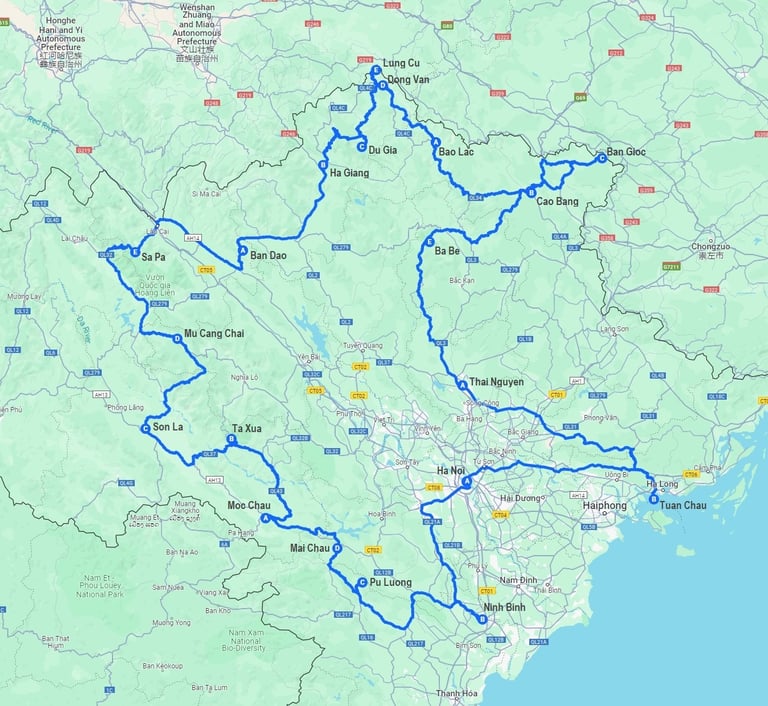
North Vietnam Solo on a Motorbike
Discoveries and Experiences
This Journal isn't merely a compilation of routes and recommendations – it's a chronicle of my discoveries from the very first day to the last. As someone who had never ridden a motorbike or traveled alone before this trip, each day was a leap into the unknown, a blend of challenges, surprises, and joys that only such an adventure could offer
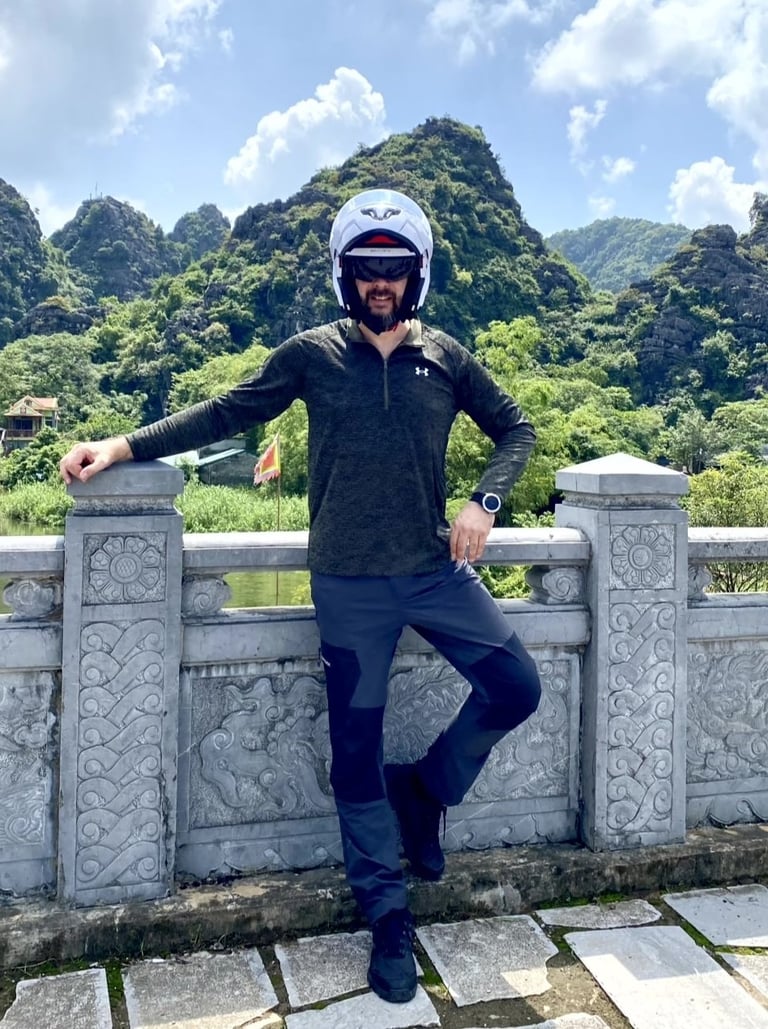

I must confess: I've always desired a motorbike but was held back by fear. Would I pass away without ever giving it a try, still afraid?
Confronting what scares you is a method to conquer fear. If this is true, then why not face it in Vietnam, the kingdom of two-wheeled vehicles?
A Dream
I had a dream that I'd nurtured for many years. To prevent it from remaining just a dream, I was determined to bring it to life.
My twenty-three-day solo motorbike journey through Vietnam turned out to be so remarkable that I felt compelled to share my experiences with those of you who might harbor similar dreams.
The Motorbike
Vietnam
A country I've visited three times already. Yet, with each departure, my desire to return and immerse myself more deeply in Vietnam only grew stronger.
Solo
I once had a debate with my cousin Ieva, who often travels solo. I argued that traveling with a partner or in a group is more enjoyable, and going alone would be extremely dull. Ieva countered, saying I simply didn’t get it.
She had a point. How could I truly understand if I had never experienced solo travel myself?
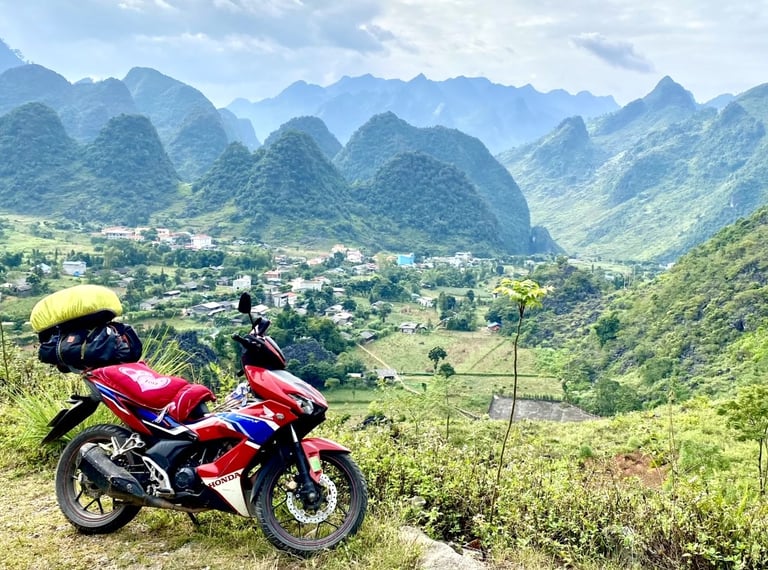

Where in Vietnam?
When I landed in Vietnam on September 28, 2023, the country had already hosted 8.9 million foreign tourists that year. Although I don’t have the exact figures, a significant number of these tourists explore Vietnam on scooters or motorbikes. Their common route spans from Ho Chi Minh City to Hanoi (or the reverse), a 2000 km journey through cities like Mui Ne, Hoi An, Da Nang, Hue, and Ha Giang.
That was my initial plan too. However, I stumbled upon some online advice that resonated with me: instead of traversing the usual route across the country, it’s more rewarding to loop around Northern Vietnam.
A minority of tourists venture into Vietnam's north. Indeed, Hanoi is a major tourist attraction, but the roads meandering through the mountains north of the capital are relatively deserted, leading through Vietnam's most stunning province. Motorbiking there offers daily new experiences - from the breathtaking beauty of nature to quaint villages, well-maintained rice fields by industrious Vietnamese, stays in guesthouses, and dinners with Thai or H'mong families.
There's no pressure to rush or see everything. You travel leisurely, following your whims and capabilities. There’s always something captivating to see. Northern Vietnam’s beauty is limitless!
My travel itinerary was crafted after reading and watching dozens of recommendations. I spent about two weeks, dedicating 1–2 hours each evening, learning everything from how to shift motorbike gears to the best local eats in Northern Vietnam's villages. That’s how I operate – my adventure begins long before the actual trip, with detailed planning of my route, duration, stops, pre-booking accommodations (always with free cancellation), and going through others' feedback and tips.
I realize not everyone has the inclination or time to devote hours to planning. This is another reason why I've decided to share my travel route and experiences.
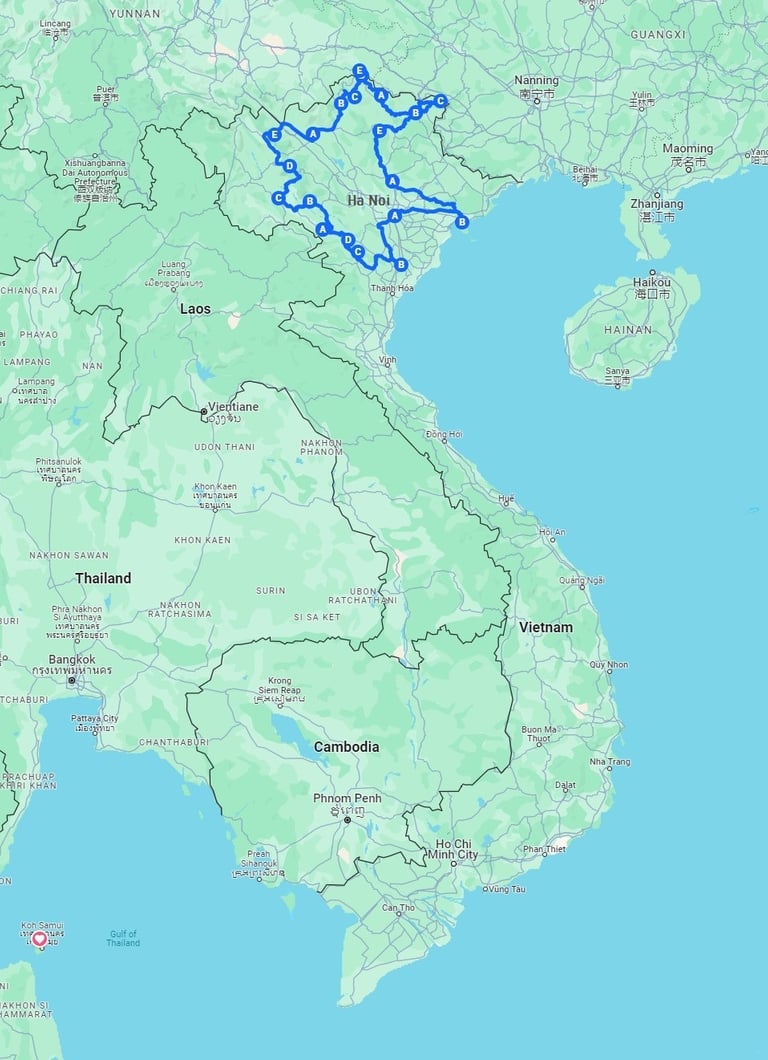

Best Motorbike?
Vietnam boasts over 45 million motorized two-wheelers, averaging one for every second resident. This easily qualifies the country as a kingdom of these vehicles!
Most seasoned bikers from Europe, America, or Australia might argue that a proper motorbike should have an engine exceeding 650 cc. However, Vietnam doesn't favor large motorbikes due to their speed, weight, and cost. The country predominantly features small motorcycles with 100–125 cc engines, making riding a larger bike both impractical and unsafe.
For my travels, I chose the Honda Winner X, the most powerful 150 cc motorbike available in Vietnam, complete with a manual 6-speed gearbox. It's exceptionally reliable, enjoyable to ride, and in my view, a compact motorbike with a sporty, attractive design. It fits seamlessly into the local traffic flow, which is vital for a comfortable ride. The bike can confidently handle steep inclines even with a larger rider like me (195 cm and 109 kg), especially in first gear. And when descending winding mountain roads, its manual gearbox facilitates engine braking, a daily necessity in these terrains.
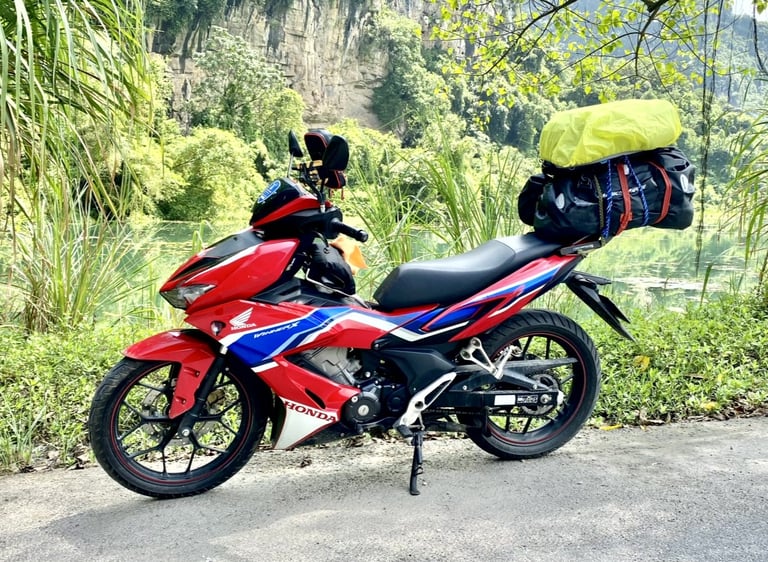

Worst Motorbike?
Most travelers, especially young backpackers, are drawn to the iconic Honda Win, a small, classically styled motorbike that's the cheapest to buy or rent.
But there's an issue – the original Japanese Honda Wins are no longer in production. If you do find an old Win, it's likely to have non-original Chinese parts. The newer Wins are simply Chinese replicas. They're prone to breakdowns and offer an uncomfortable, unsafe, and unpleasant ride. These knock-offs are only suitable for those who've never ridden a real motorbike. Backpackers might think that a cheaply bought or rented bike is cost-effective, but it's a false economy. Frequent repairs for loose bolts, slack chains, faulty brakes, unresponsive clutches, and engines that won't start are common. The engine oil needs changing every 500 km to avoid seizure.
My advice is to steer clear of the fake Honda Wins, unless you're a backpacker who doesn’t mind frequent tire punctures and garage visits.
Scooters with automatic gearboxes, though sleek and convenient for city use with their small wheels, rear engine, and spacious under-seat storage, are not suitable for long distances, mountainous terrains, or off-road conditions. Breakdowns during long trips can be costly to repair.
If a manual gearbox motorbike isn't an option for you, consider a small motorbike with a semi-automatic gearbox. You'll still shift gears but without a clutch. Models like the Honda Blade are immensely popular in Vietnam. They're affordable, reliable, fuel-efficient, and adept on both city streets and rural roads. They're even used as cargo vehicles by locals, carrying everything from livestock to sofas, often with an entire family aboard.
Lastly, avoid large, powerful motorbikes. While they can be rented, they are expensive and impractical for Vietnamese conditions.
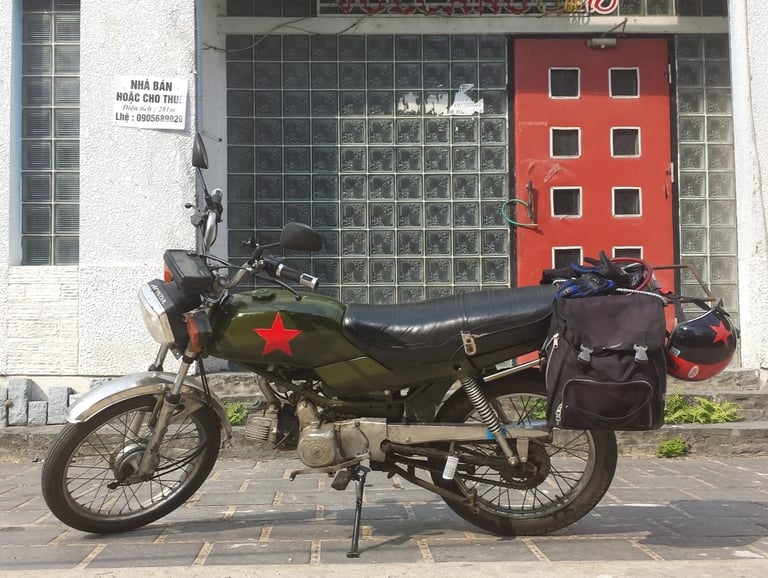

Where to Rent?
There are many rental places in Hanoi. A week before the trip, I googled 'motorbike rent Hanoi', found three places renting Honda Winners and wrote to them on WhatsApp. The first to reply was Lily from Happy Zip Motorbikes, offering two Winner X options: 350K VND (13.80 EUR) per day for a new 2023 model and 300K VND (11.80 EUR) for the 2022 model. I said I wanted the motorbike for 24 days and that I would have my own helmet. I asked for the best discount possible. Within a minute, I got a 50K VND (2 EUR) discount per day. Great! I immediately decided against the new bike, as scratches are more visible on it than on an older one, whose plastic doesn't shine everywhere. Renting a new one for 24 days would cost 283 EUR, and the 2022 model – 236 EUR. I saved 47 EUR. That's a significant amount in Vietnam.
The second offer came from Offroad Vietnam. They asked for 300 USD for a 2018 Honda Winner (the same price as for a new Winner X from Happy Zip Motorbikes).
The third rental place could have been Tigit Motorbikes. Apparently, it's one of the most serious rental agencies in Vietnam, with the largest fleet of motorcycles and scooters. You can reserve a motorbike on the Tigit Motorbikes website, where you'll find a lot of useful information – from motorbike technical specifications to a culinary guide. Definitely worth reading before the trip
! The rental company will require a deposit for the period of the motorbike rental. Happy Zip Motorbikes, for instance, asked for a 500 USD deposit in cash or a passport for renting a Winner for 24 days. I advise against giving your passport as a deposit. It's necessary for currency exchange at banks (where ID cards aren't accepted) and for identification in unexpected situations. Though unlikely, there's a risk of the rental company claiming losses higher than 500 USD, which you might dispute. Handing over your passport can make you vulnerable. I chose to leave a cash deposit of 400 EUR and received it back without any issues after returning the Winner.
! Ensure to reserve or at least pre-arrange your motorbike rental. Otherwise, you might spend a whole day in Hanoi searching for the right bike, possibly without success. Don’t waste precious time when there’s so much to explore in Hanoi.
! Verify the motorbike’s technical state: check for fresh tire treads, functioning lights and turn signals, a tight chain, and sufficient engine cooling and brake fluids. Inquire about the last engine oil change and the interval for the next change. A test drive is crucial to assess the brakes' responsiveness, clutch engagement, and gear shifts, etc.
! Remember to check the horn's functionality. You'll find it essential to use frequently. Practice quickly locating and pressing the horn button with your thumb. It’s an important tool for signaling other road users with messages like 'hey, I’m driving here!', 'watch out, I’m turning!', or 'what are you doing, idiot?
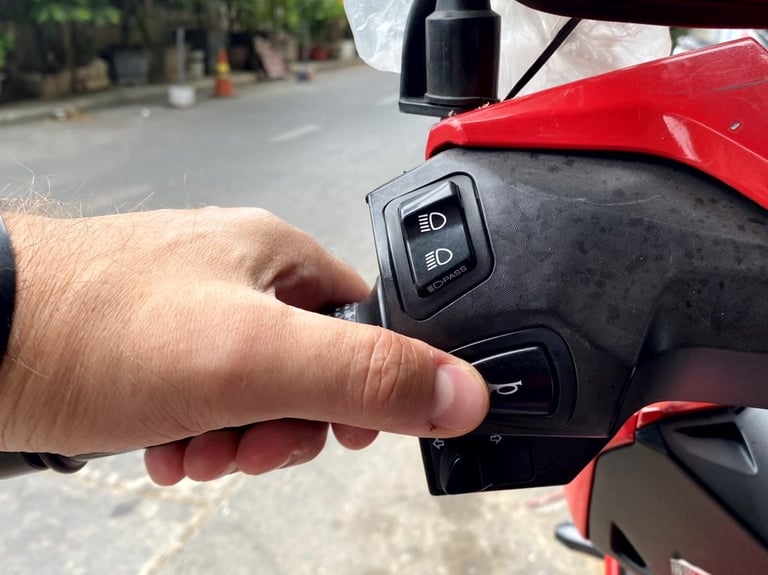

You might be amazed by the vast array of accommodation options in Vietnam, ranging from a cheap mattress in a 16-bed room without windows to luxurious five-star hotels with pools, SPAs, and more. The choice is yours.
The most affordable accommodations are guesthouses and hostels. Typically, you'll find options like a mattress or bed starting at 4 EUR in shared spaces, or private rooms at twice the price. Facilities like toilets and showers are shared, and air conditioning is often replaced by basic fans. This isn't much of an issue in the cooler mountain regions, but in the hotter, more humid lowlands, air conditioning can greatly enhance comfort.
Many budget guesthouses are wooden structures with limited or no soundproofing. For instance, it's possible to reach outside through gaps where the wall meets the roof. Light sleepers might hear everything from their neighbors to early morning roosters, hardworking hosts, or even, as I once experienced, a loud street-side radio broadcast at six in the morning.
A significant advantage of staying in guesthouses is the opportunity to have dinner with the host family. While not a universal feature, my recommendations and other reviews on booking.com can guide you to places where evening solitude is rare.
For those seeking tranquility and greater comfort, consider the slightly pricier guesthouses and hotels. In Vietnam, 'more expensive' is still relatively cheap compared to European standards. You might be astonished to find that a night's stay in a superb hotel room with breakfast in Vietnam can be two to five times less expensive than in Europe.
I prefer planning my accommodations in advance and booking through booking.com, always opting for free cancellation options. If unavailable, I reserve a day ahead of arrival. I've learned from past travels that searching for last-minute accommodations can lead to uncomfortable, overpriced stays in less-than-ideal locations.
Where to Sleep?
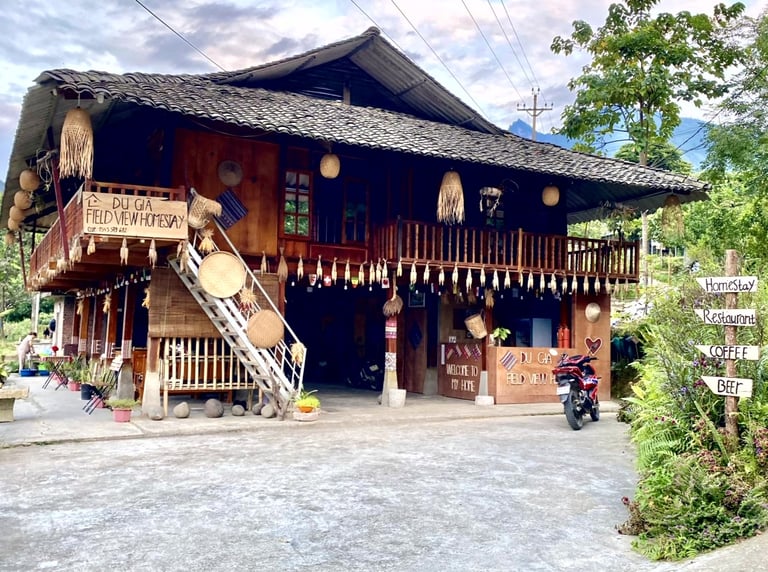

When to Travel?
The optimal period for motorbike travel in Northern Vietnam is from late September to November. During this time, the weather is comfortably warm, and rain, if any, is infrequent and short-lived. Autumn stands out as the most stunning season, with the lush green valleys entering the harvest season right after the summer and monsoon period.
Spring, spanning March to April, also offers favorable weather for motorbiking, though the natural scenery isn’t quite as breathtaking as in autumn.
Traveling in winter requires warm clothing, as temperatures in the high mountain passes can approach or dip below freezing. Motorbiking in these conditions, even with appropriate attire, can be challenging.
Summer is generally less suitable for motorbike travel, characterized by intense heat and frequent, prolonged rainfall.
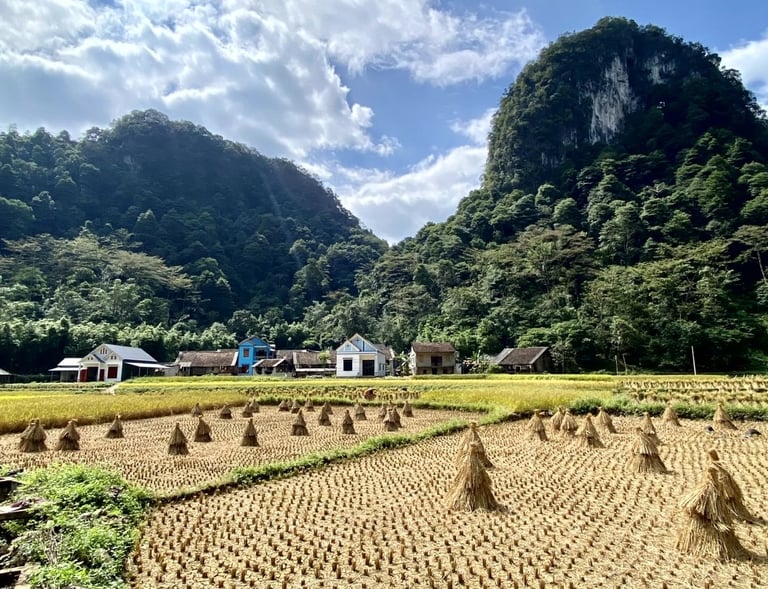

Check here to see if you need a visa for Vietnam. If so, no worries! You can get an e-visa within 3 days by submitting your personal information and paying a fee of 25 USD. The e-visa is valid for up to three months and can be single-entry or multiple-entry, with the latter costing 50 USD.
In your e-visa application, you must specify your port of entry in Vietnam. It's crucial to know whether you'll be flying directly to Hanoi or transiting through another Vietnamese city. For instance, my flight with Turkish Airlines routed from Vilnius to Istanbul to Ho Chi Minh City, and finally to Hanoi, making Ho Chi Minh City my port of entry. Upon arrival in Ho Chi Minh, I underwent immigration checks, received a passport stamp, transferred from the international to the domestic terminal, and then continued to Hanoi. Had I mistakenly listed Hanoi as my port of entry, I would have had to reapply for the e-visa at Ho Chi Minh airport. Be careful to avoid this error.
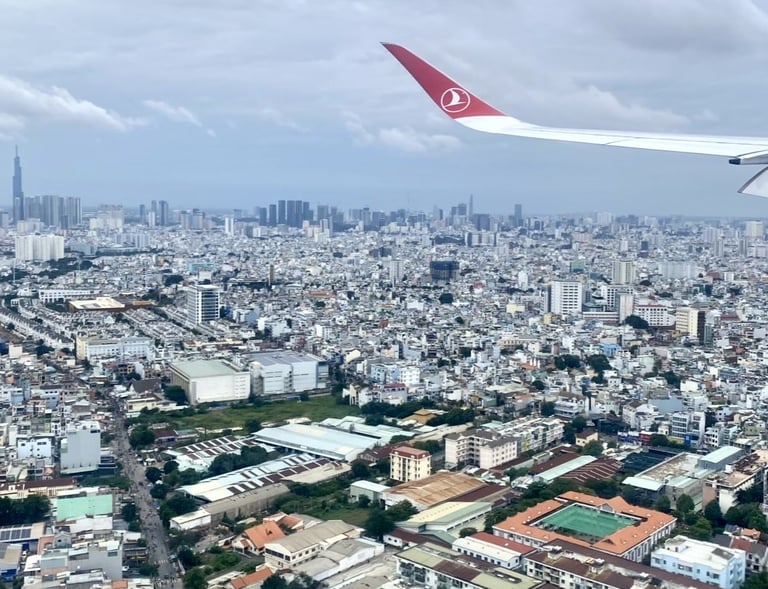

Visa Required?
What to Pack?
You can’t feasibly carry more than 15 kg on a motorbike. Overloading the luggage rack impacts the rear suspension and raises the center of gravity, making the bike more difficult to handle. A large bag or suitcase can transform the journey into an ordeal. If you think you need more than 15 kg of items including evening shoes, dresses, etc., you're planning the wrong kind of trip.
I used a waterproof bag, impervious to rain and mud, allowing me to wash the bike without removing it. For efficient packing, I used two crescent-shaped bags from Decathlon. These zippered bags were incredibly useful for daily packing during my trip.
A lightweight backpack is useful for easy access to items while riding, avoiding the need to dismantle the larger bag from the rack.
Long-sleeved shirts: two for riding (one can suffice).
Short-sleeved sports shirts: one for hiking, two for changing into in the evening.
Comfortable riding pants (elastic Karrimor hiking pants worked well for me).
A lightweight, warm sweater (one merino wool Husky sweater was sufficient).
A wind and rain-resistant sports jacket (I used a thin Adidas Terrex).
2 pairs of socks for riding, preferably thicker to prevent sweating.
2-3 pairs of socks for evenings.
2-3 pieces of underwear.
Shorts for evenings.
Swimming shorts or something suitable for diving into pools and waterfalls.
A lightweight towel.
Sturdy, comfortable footwear for riding. I used Adidas Terrex hiking shoes, but mine didn't protect the ankles, which can be a concern when motorbiking.
Evening footwear. Crocs or flip-flops work well; I had both light sports shoes and crocs, but mostly wore crocs.
Motorbiking gloves should be comfortable and suited for warm weather. Forget about waterproof ones; when it rains, either ride without them, cover them with plastic bags, or don't ride.
A helmet is provided by rental agencies, though their quality is average. I brought my own convertible helmet with a lift-up chin guard. Riding with an open helmet was more enjoyable, especially at low speeds, for better enjoyment of the surroundings.
Sunglasses. They must be comfortable to wear with a helmet. It's even better if the helmet includes integrated sun lenses – with a simple hand movement, you can raise or lower a lens that reduces sunlight glare. This is both convenient and cool.
Backpack Rain Cover. Keep it always on, even if the forecast is sunny. You are traveling in North Vietnam, where rain can surprise you just a few bends down a mountain road.
Rain Poncho. Locals often use disposable polyethylene rain covers, which can be cheaply purchased in small shops. I recommend having something better than a 'plastic bag' – a more substantial cyclist's poncho would be perfect.
Shoe Rain Covers. I couldn't find motorbike-specific shoe covers in my Hometown before my flight to Vietnam, and it was too late to order online. So, I used ordinary plastic bags to protect my shoes from the rain during my journey. Later, I discovered specialized shoe covers for 30K VND (about 1.20 EUR per pair) in a local shop. These slip over the shoes and are more durable than plastic bags, especially when shifting gears. There might be special shoes that are both rainproof and breathable in hot weather, but I'm not sure. Plastic bags were the simplest solution for me.
Belt Wallet. I purchased a compact belt on Amazon to securely carry my passport, cash, and credit cards. It's important to safeguard these items, so a belt wallet is a practical solution. (Additionally, I stored a spare card in my backpack and another in a different location. It's wise not to keep all eggs in one basket.)
Cosmetics. It's up to you to decide what to bring, but remember, only pack essentials. Also, anything that can leak probably will, so pack all liquids in airtight bags.
Sunscreen. I'm highlighting this separately from other cosmetics. Apply it generously, preferably a high SPF (I used SPF 50, which worked well). The Vietnamese sun is potent, even through clouds.
Pocket Microfiber Towel. Sometimes the heat causes profuse sweating. I always kept a small towel within reach.
Due to inexperience, I overpacked for my trip to Vietnam. I brought 5 shirts unnecessarily, as I bought three more in Hanoi (each for 100K VND, about 3.90 EUR, which were Under Armor lookalikes and served me well). I also unnecessarily lugged around a neck pillow, useful only for long flights. The second pair of shorts went unworn. Noise-cancelling headphones were used only on the plane and once to escape loud evening karaoke.
! Never ride without a helmet.
! Though tempting, avoid riding in short sleeves and shorts. There's always a risk of falling off the motorbike. Consider how exposed skin would fare in a fall.
! Riding in flip-flops, as some locals do, is a bad idea. I had a couple of incidents where sturdy shoe soles prevented falls (there were actually three, but I’ll elaborate on the third another time).
! Don't drink and drive. In Vietnam, the legal alcohol limit for motorbike drivers is zero. Mixing alcohol with motorbike riding equals big trouble.
! Each morning, ensure you have at least a liter of drinking water for the day's journey."
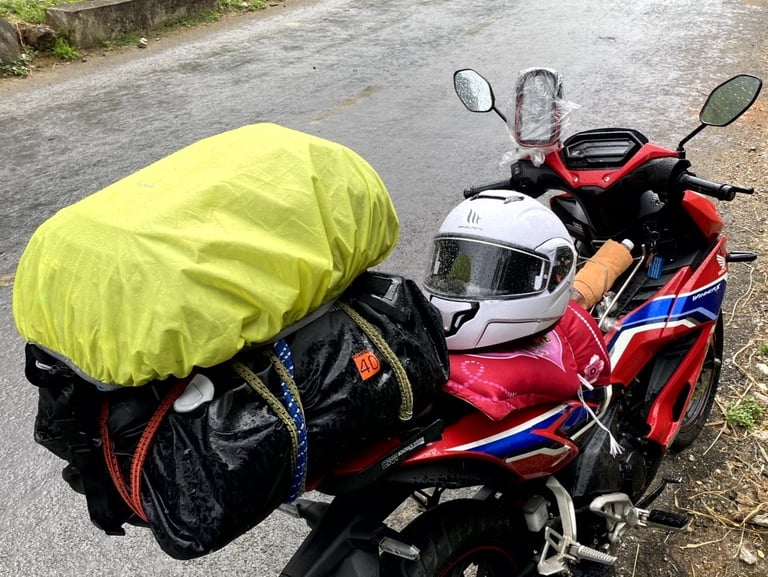

Driver's License. In Vietnam, you can only drive mopeds up to 50 cc without a license. For more powerful two-wheelers, an A category license is theoretically required. However, many tourists ride motorbikess without an A category license in practice. Rental companies often rent out motorbikes without asking for a valid license. This is the common practice.
Traffic Police. They are aware that foreigners typically don't have an A category license. They set up checkpoints on highways, in cities, and near Ha Giang. It's their job to stop foreigners and collect fines. Even if a foreigner's license includes an A category, the officer will claim that only Vietnamese licenses are valid. International licenses? They're considered invalid because, if valid, the officer couldn’t collect fines. I've heard that the police usually ask for 3 million VND (118 EUR).
If Stopped by the Police. First off, pretend you don't speak English (or Vietnamese). The officer will write a few sentences and the number 3.000.000 on Google Translate. Depending on whether you have an A category or an international driver's license, respond with smiles, write in Translate about your love for Vietnam, your long travels, and the beautiful weather. Stretch out the conversation. Make typing errors, write with mistakes, and mention that you've already paid a fine. As time passes and other tourists without valid licenses pass by, the officer loses potential income. When you notice the officer's attention diverting to other road users, discreetly offer 200K VND (7.90 EUR) as your fine. Never hand over your passport or motorbike key to the officer, as negotiating becomes harder if they take possession of your belongings.
I was never stopped by the traffic police, which was lucky. Perhaps my approach helped – upon seeing a police checkpoint, I would sit upright on my Winner, raise my hand, and greet them warmly. The officers would respond similarly, letting me pass, possibly thinking I had already been stopped and fined. I never had the opportunity to confirm this theory.
Travel Insurance. Check the terms to confirm if the insurance covers incidents occurring while riding a motorcycle. Consult with an insurance agent to find the insurance that best suits your needs.
Money Exchange. Banks offer the best exchange rates. In Hanoi, I used Vietcombank to exchange euros for Vietnamese dong at a 3% surcharge over the official exchange rate. I only exchanged a third of the money I needed for the trip, to avoid carrying too much cash.
ATMs are widely available for withdrawals, though not in remote areas. Vietnam has over 30 different banks and corresponding ATMs. I found Agribank ATMs to offer the most favorable rates. The maximum amount per withdrawal was 3M VND, with a charge of 22K VND by Agribank and an additional 3% by my bank, Luminor. Therefore, withdrawing VND ended up costing 3.73% more than the official online exchange rate. I once used an ACB ATM, which charged a 122K VND (4.80 EUR) commission – significantly higher than Agribank.
Connectivity. On long journeys, having a local internet connection is essential. There are three main mobile operators in Vietnam: Viettel, MobiFone, and Vinaphone. Viettel generally offers the best coverage in Northern Vietnam.
I purchased a SIM card with a 30-day unlimited data package for 300K VND (11.80 EUR) at Ho Chi Minh airport while waiting in the immigration queue. It might have been slightly cheaper in Hanoi's streets, but I could pay by card at the airport, and they immediately set up the SIM in my phone.
Navigation. For the journey, I had two phones. In Vilnius, I bought a new Redmi 12C for 100 EUR. This phone, with the Vietnamese SIM card, was used solely as a navigator and Wi-Fi hotspot. I charged its battery overnight, set up the Google Maps route in the morning, placed it in the motorbike holder, and didn't touch it till the day's end. The battery never went below 30%, and I never had to use my power bank (which was small). Therefore, a powerful power bank or a motorbikee with a USB port (I believe the 2023 Winner X model has one) isn't necessary.
The rented motorbike will likely come with a phone holder. I brought my own – not just a simple holder, but a special case that's rainproof. After the first downpour, it was soaked, so I always kept a small plastic bag handy to cover the phone case as a rain shield.
! Remember to set Google Maps to avoid highways and toll roads (Settings -> Navigation -> Avoid Tolls and Avoid Motorways). My Android phone's Google Maps had an option for motorbike routes – in Vietnam, there are roads inaccessible to cars, so selecting the motorbike icon reveals many fun routes.
! The outlets in Vietnam are both A and C type in one, with a voltage of 220V. If you forget your charger, you can buy one at a reasonable price in Hanoi.
Photography and Filming. You'll want to take many photos in Vietnam! However, I don’t recommend carrying a professional DSLR camera with lenses on a motorbike unless your trip to Northern Vietnam is for a professional photo album. A serious camera is a bulky item, and it’s best to travel light on a motorbike.
I took two phones: a Redmi 12C for navigation and an iPhone 11 Pro for photos and filming. I kept the iPhone in my pocket and sometimes hung it around my neck with a string for quick access to take photos!
Is it worth bringing a GoPro or other video equipment? If your goal is to create a film about Vietnam and you have the skills, then yes. Filming requires skill, and editing the footage is labor-intensive. Consider whether you want to engage in this work. Filming on a motorbike is not easy; it requires time and effort. You might not have time to enjoy the motorbike trip and the beauty of Vietnam.
Securing Items. The rental company will provide one or two rubber straps with hooks at the ends. Improperly secured bags or backpacks can be lost. Once, my poorly secured backpack tilted to the side and hung by only one hook of the strap (fortunately, I noticed in time through the rearview mirror). The next day, I tightened the backpack too much, and sunscreen leaked out of a compressed bottle. One side of the backpack was well protected from sunburn...
! Securing items with rubber straps can be risky. A friend told me about a tourist who lost an eye when a strap came loose. Remember this when you bend down to hook the strap under the luggage.
Comfortable Seating. After the first day, I felt my tailbone more than usual. The pain grew deeper, and after a few more days, it hurt even without touching. I won’t go into the issue of a small motorbike and a large rider... One day, I had an epiphany and found a simple solution to significantly improve riding comfort, which I will discuss later.
Motorbike Parking. An improperly parked motorbike might not be there when you return. A carelessly parked motorbike (A) might be towed by the police or (B) taken by thieves. Therefore, park only in designated areas – look for a sign, a parking lot near a hotel, guesthouse, restaurant, etc. In larger lots, there is usually a security guard who may charge a small fee for parking. This is a standard practice and works well. Sometimes, the security guard or hotel owner will move the motorbike to a safe place overnight. Don’t panic if your vehicle isn’t where you left it in the morning. First, ask around, then start worrying.
Clean Clothes. In every small town in Vietnam, there are laundry services. You can ask at your guesthouse or hotel, or they might take care of your laundry for you. The service costs 30-50K VND (1.20-2 EUR) per kilogram. They even wash shoes for 40-50K VND (1.60-2 EUR). Drop off dirty clothes in the evening, get them clean in the morning. It’s incredibly convenient and affordable (so there's no need to bring many clothes!)
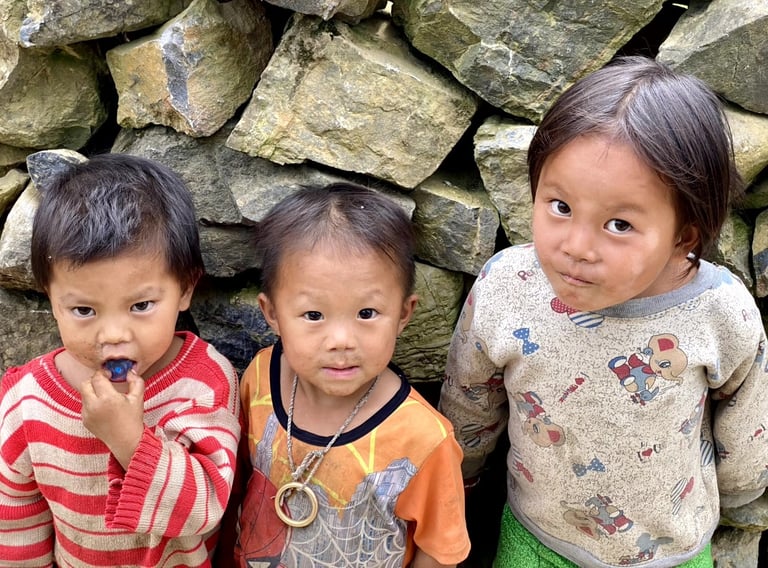

What Else?


